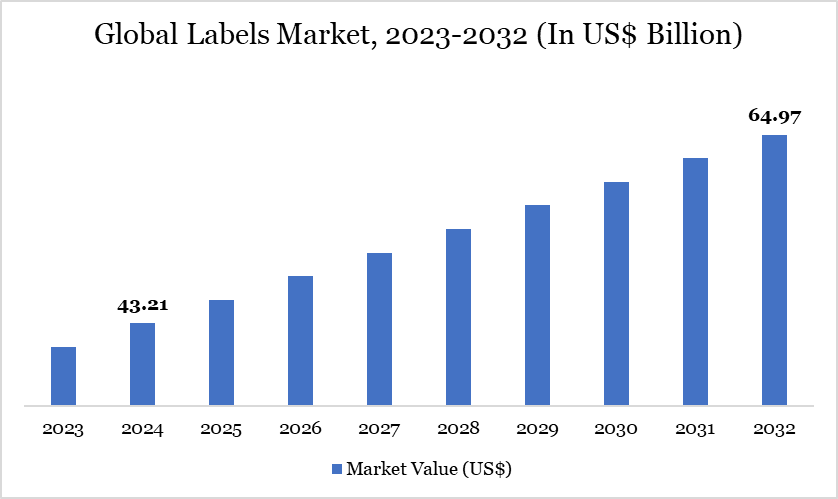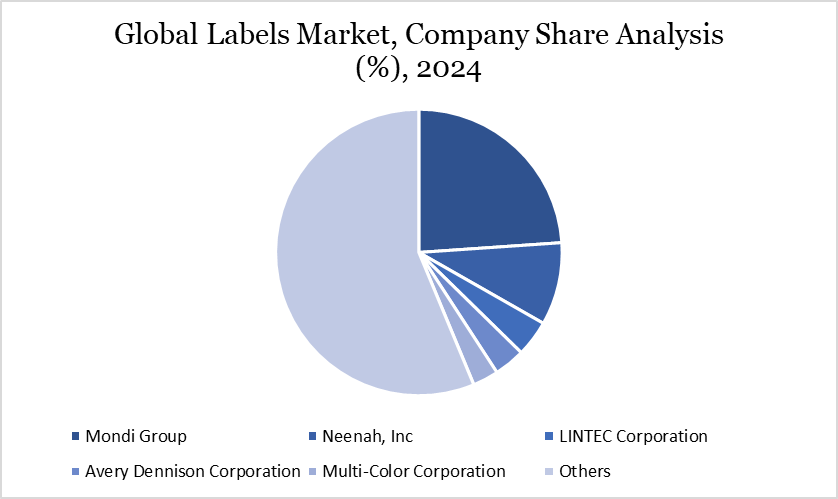Labels Market Overview
Labels Market reached US$ 43.21 billion in 2024 and is expected to reach US$ 64.97 billion by 2032, growing with a CAGR of 5.23% during the forecast period 2025-2032.
The global label market is experiencing substantial growth, driven by innovations in printing technologies such as digital and flexographic printing, which enhance efficiency, cost-effectiveness and flexibility. The advancements allow industries like food and beverage, pharmaceuticals, consumer goods and logistics to streamline operations, improve product traceability and engage consumers more effectively.
The market is shifting toward more sustainable labeling solutions, as companies prioritize eco-friendly materials in response to growing consumer demand and regulatory pressures. There is an increasing focus on biodegradable, recyclable and compostable materials to minimize environmental impact and align with global sustainability goals.
Labels Market Trends
The global labels market is experiencing significant transformation, driven by evolving consumer preferences, sustainability initiatives, regulatory changes, and technological innovation. One of the most prominent trends is the growing demand for sustainable and eco-friendly labels. With global brands committing to carbon neutrality and environmentally responsible packaging, there is a surge in demand for recyclable, biodegradable, and compostable label materials.
For instance, Avery Dennison has developed linerless labels and recycled content labels to support circular economy goals, while UPM Raflatac introduced Forest Film, a renewable label material made from wood-based raw materials. Another key trend is the rise of smart and interactive labeling technologies. Labels are no longer just for branding they now serve as a tool for Type authentication, customer engagement, and supply chain transparency.

For more details on this report – Request for Sample
Market Scope
| Metrics | Details |
| By Type | Pressure Sensitive Labels, Shrink Labels, Stretch Labels, Wet Glue Labels, Others |
| By Material | Plastic, Paper, Foil |
| By Printing Technique | Flexographic Printing, Digital Printing, Gravure Printing, Offset Printing, Others |
| By Application | Food and Beverages, Pharmaceutical, Cosmetics & Personal Care, Chemicals, Automobiles, Others |
| By Region | North America, South America, Europe, Asia-Pacific, Middle East and Africa |
| Report Insights Covered | Competitive Landscape Analysis, Company Profile Analysis, Market Size, Share, Growth |
Labels Market Dynamics
Advancements in Printing Technologies
Advancements in printing technologies like digital, flexographic and direct-to-container printing are driving the global label market. Digital printing, in particular, offers flexibility, cost-efficiency and the ability to print variable data, making it ideal for customizable and small-run production. For instance, QR codes and augmented reality (AR) are revolutionizing how consumers interact with products.
Labels with QR codes can link to digital content, such as product information, user manuals, or promotional videos. Augmented reality takes this a step further by offering immersive experiences. Additionally, one of the most significant trends influencing the future of labeling is the integration of Internet of Things (IoT) technology. Labels embedded with IoT capabilities can transform ordinary products into smart, connected items.
This integration allows real-time tracking, enhanced supply chain visibility, and even consumer interaction. Thus, the combined growth of packaged goods consumption and online retail has created a robust and sustained demand for versatile, high-performance labeling solutions, making it one of the strongest growth engines of the global labels market.
Rising Cost of Raw Materials
Materials such as paper, plastic and adhesives are essential for label production and their prices have been fluctuating due to global supply chain disruptions, commodity price volatility and geopolitical factors. These increases in raw material costs directly impact manufacturers, leading to higher production expenses.
For food and beverage or retail businesses, these rising costs can result in thinner profit margins, forcing them to pass it on to consumers, leading to reduced demand in price-sensitive markets. The impact of rising raw material costs is felt across the entire value chain of the labels market. As manufacturers face higher input costs, the end price of labels can increase, which affects the overall affordability of products that rely on labeling.
Labels Market Segment Analysis
The global labels market is segmented based on type, material, printing technique, application and region.

Paper as a Pillar of Sustainable Labeling Trends
Paper-based labels are a key material type driving the global labels market, primarily due to their cost-effectiveness, printability, and increasing alignment with sustainability goals. For instance, Archipelago Technology has introduced a breakthrough in sustainable packaging with its Powerdrop non-contact coating machine.
This advanced inkjet system precisely jets viscous, glue-like coatings—something traditional spray methods can't handle effectively. Powerdrop enables manufacturers to waterproof rigid paper containers without contaminating the inner paper core, allowing for full recyclability. This innovation addresses the growing need for sustainable paper packaging by providing an eco-friendly alternative to single-use plastic items like cups, bowls, and bottles, while ensuring durability and recyclability.
Therefore, paper as a label material drives the market by offering a balance of affordability, sustainability, and versatility. Its compatibility with various printing technologies and alignment with environmental goals makes it the material of choice across multiple end-user industries, further cementing its role in the continued growth of the global labels market.
Labels Market Geographical Share
North America at the Forefront of Labeling Innovation and Sustainability
North America dominates the global labels market due to its well-established packaging industry, advanced technological adoption, and strong presence of major consumer goods, retail, and e-commerce players. The region is home to global FMCG giants like Procter & Gamble, PepsiCo, Johnson & Johnson, and Kraft Heinz, all of which demand high-quality and compliant labeling solutions for their wide product portfolios.
These companies invest heavily in innovative label designs, including smart labels with RFID and NFC technologies for inventory management and consumer engagement. For instance, Walmart and Target have implemented smart shelf labeling systems that rely on dynamic labels to manage pricing and stock levels efficiently.
Moreover, stringent regulatory requirements by agencies like the US Food and Drug Administration (FDA) and the Environmental Protection Agency (EPA) drive the need for precise, compliant, and detailed labeling especially in food, pharmaceutical, and chemical industries. This has prompted manufacturers to adopt advanced digital printing and inspection systems to ensure compliance and product safety.
Sustainability Analysis
Sustainability is becoming a central pillar in the global labels market, as environmental concerns, regulatory pressures, and shifting consumer preferences push companies toward greener solutions. Label manufacturers and end-users are increasingly adopting eco-friendly materials, such as recyclable paper, biodegradable films, and adhesives free from harmful chemicals.
A major focus is on reducing label waste, particularly the liner waste generated from pressure-sensitive labels. Innovations like linerless labels, which eliminate backing material altogether, are gaining traction for their ability to significantly cut down on waste and carbon emissions. Companies such as UPM Raflatac and Avery Dennison have introduced recycled-content labels and wash-off adhesives that facilitate recycling of PET bottles and glass containers without leaving residue.
Labels Market Major Players
The major global players in the market include Mondi Group, Neenah, Inc, LINTEC Corporation, Avery Dennison Corporation, Multi-Color Corporation, Huhtamaki Group, Berry Global Inc, UPM Raflatac, CCL Industries, Klöckner Pentaplast and among others.

Key Developments
In November 2024, Munbyn launched the Realwriter RW402, a direct thermal label printer designed for small businesses, offering fast, ink-free printing of 4 x 6-inch shipping labels with USB and Bluetooth connectivity.
In August 2024, Innovia Films launched RayoForm ELR70, a semi-cavitated BOPP film for in-mold labeling on large containers. Its reduced density, high stiffness and two-sided treatment enhance molding and printing performance on PP and PE containers (5-25 liters).
In September 2024, Avery Dennison introduced INGEDE12-certified paper labels with an adhesive that improves paper recycling quality. The range includes sustainable options like rVellum (100% recycled) and meets EU recyclability standards.
Why Choose DataM?
Data-Driven Insights: Dive into detailed analyses with granular insights such as pricing, market shares and value chain evaluations, enriched by interviews with industry leaders and disruptors.
Post-Purchase Support and Expert Analyst Consultations: As a valued client, gain direct access to our expert analysts for personalized advice and strategic guidance, tailored to your specific needs and challenges.
White Papers and Case Studies: Benefit quarterly from our in-depth studies related to your purchased titles, tailored to refine your operational and marketing strategies for maximum impact.
Annual Updates on Purchased Reports: As an existing customer, enjoy the privilege of annual updates to your reports, ensuring you stay abreast of the latest market insights and technological advancements. Terms and conditions apply.
Specialized Focus on Emerging Markets: DataM differentiates itself by delivering in-depth, specialized insights specifically for emerging markets, rather than offering generalized geographic overviews. This approach equips our clients with a nuanced understanding and actionable intelligence that are essential for navigating and succeeding in high-growth regions.
Value of DataM Reports: Our reports offer specialized insights tailored to the latest trends and specific business inquiries. This personalized approach provides a deeper, strategic perspective, ensuring you receive the precise information necessary to make informed decisions. These insights complement and go beyond what is typically available in generic databases.
Target Audience 2024
Manufacturers/ Buyers
Industry Investors/Investment Bankers
Research Professionals
Emerging Companies
